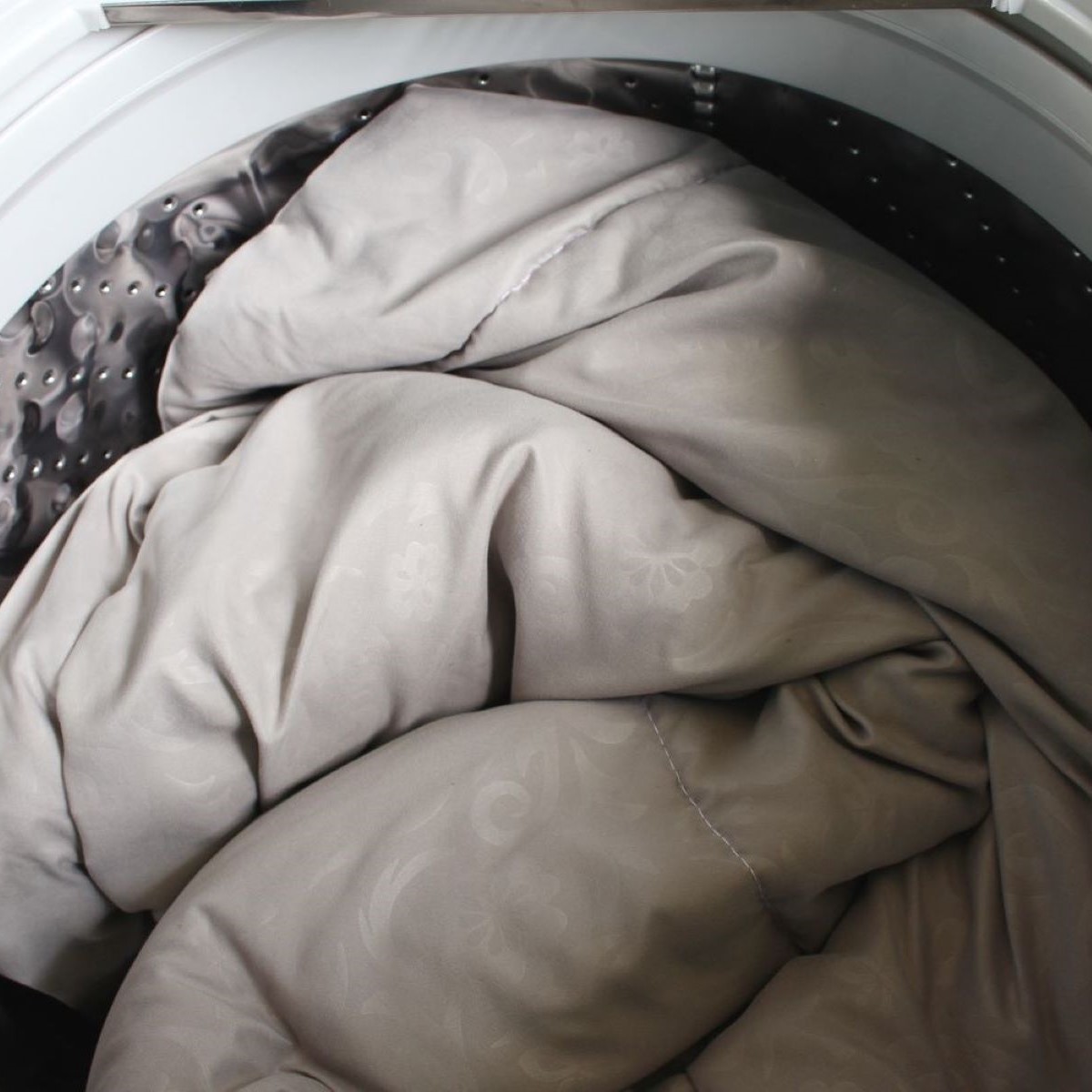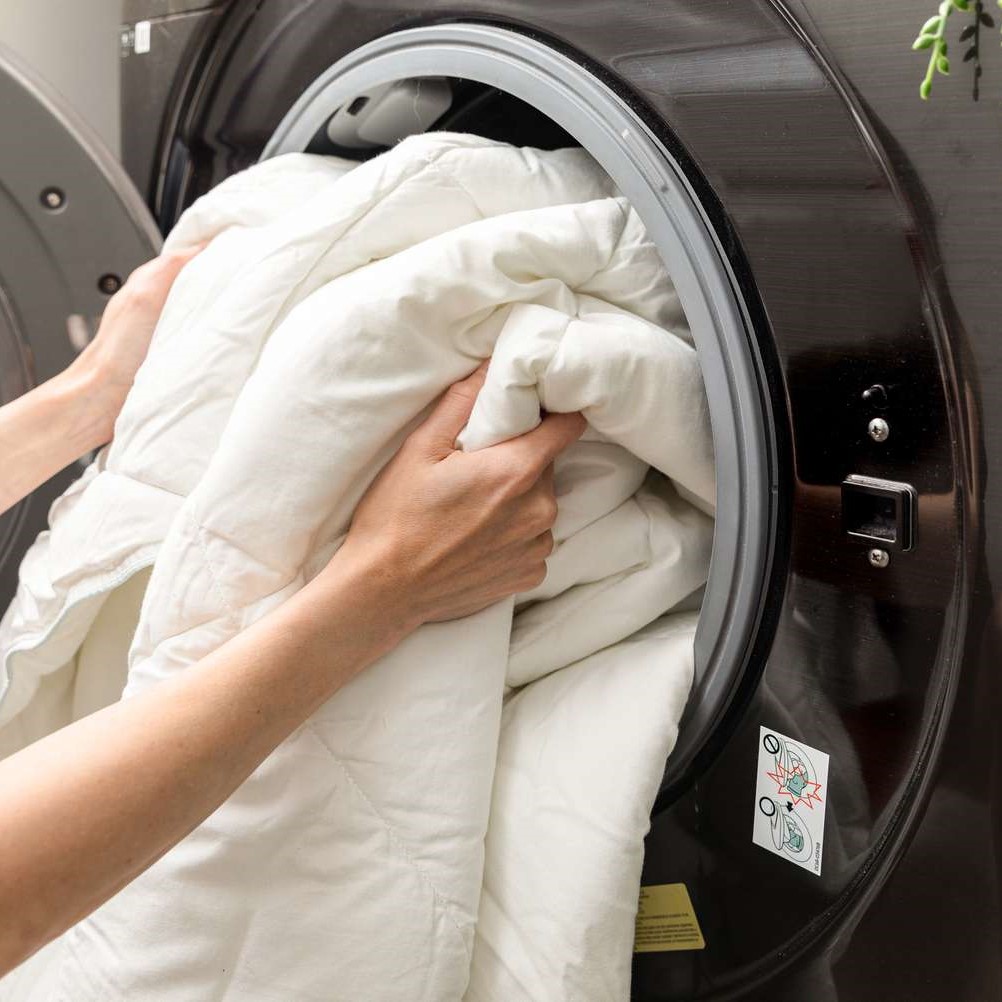Preparing Your Comforter for Washing
Before you grab your detergent and start the washing machine, a proper preparation of your comforter is key to successful cleaning. This includes understanding the manufacturer’s instructions and taking care to treat any spots or damage.

Checking Care Labels and Manufacturer Instructions
Firstly, always check the care labels on your comforter. These instructions will tell you whether it is safe to wash in a machine or if dry cleaning is a must. They also provide vital information on suitable temperatures and detergents. Ignoring these could harm your comforter.
Spot Treating Stains and Repairing Tears
Next, inspect for any stains or tears. Use a mild stain remover on any spots. Be gentle to avoid spreading the stain. If you find small tears or loose threads, mend them before washing. This prevents the damage from getting worse during the cleaning process. Proper preparation ensures a clean and intact comforter after washing.
Choosing the Correct Washing Machine
Understanding the Capacity Requirements for Your Comforter
To wash a comforter correctly, check that it fits in your washing machine with room to move. The comforter needs space to agitate properly for thorough cleaning. If it’s too tight, consider using a large commercial washer.
The Advantages of Front-Loading Washing Machines
Front-loading washing machines are ideal for comforters. They handle large items better and are gentler on fabrics. The absence of an agitator prevents damage to your comforter. Also, they usually offer more wash settings suitable for bulky items like comforters.
Selecting the Right Detergent and Wash Settings
Choosing the correct detergent and settings is crucial for effectively washing your comforter without causing damage.
The Importance of Mild or Natural Laundry Detergents
It’s essential to use mild or natural laundry detergents when washing your comforter. Harsh chemicals can degrade the fabric and filling of your comforter, reducing its lifespan and comfort. Opt for detergents that are labeled as gentle, fragrance-free, or made for sensitive skin. This helps maintain the integrity of your comforter while ensuring it is thoroughly cleaned.
Wash Cycle and Temperature Recommendations
Select the gentle or delicate cycle on your washing machine to prevent damage to your comforter. Always refer to the care label for the recommended wash temperature. Cold or warm water is usually best to preserve the fabric’s color and texture. Avoid hot water as it can shrink or damage certain comforter materials. Adding an extra rinse cycle can help remove all detergent residues, keeping your comforter fresh and allergen-free.
The Washing Process Step by Step
Learning how to wash comforter in washing machine is straightforward when you follow these steps.
How to Properly Load Your Comforter
Before placing your comforter in the machine, make sure there’s enough space. It shouldn’t be packed tightly, as movement is required for a thorough clean. Once you confirm your washer’s capacity, place the comforter inside, spread evenly to allow water and detergent to reach every part efficiently.
The Role of Extra Rinse Cycles
An extra rinse cycle is beneficial. It removes any remaining detergent, keeping your comforter fresh and reducing the risk of skin irritation. Choose the extra rinse option, if available, to ensure a thorough clean. This step is significant for those with sensitive skin or allergies, as it helps prevent any detergent residue from lingering in the fabric.
 Drying Your Comforter Effectively
Drying Your Comforter Effectively
Once your comforter is clean, the next step is drying it properly. This step is just as important as the wash cycle. The right drying method ensures your comforter stays fluffy and lasts longer.
Using Tennis Balls or Dryer Balls for Even Fluffiness
Using tennis balls or specialized dryer balls can significantly help. They keep the filling from clumping together. This trick helps in maintaining the comforter’s fluffiness throughout the drying cycle. Simply toss a couple of these balls in the dryer with your comforter.
Low Heat and Air Drying Options
To keep the fabric and filling safe, always use a low heat setting. If possible, try air drying your comforter. Spread it out evenly over a clean, dry surface. Wait until it’s fully dry before use. Air drying takes more time but it’s gentle on fabrics.
Fluffing and Rearranging During the Drying Cycle
It’s important to check your comforter every so often while it dries. Take it out of the dryer to fluff and rearrange it. This will help it dry evenly. It’s a simple step that prevents moisture pockets and ensures thorough drying.
Post-Wash Care
Proper post-wash care extends the life of your comforter and keeps it fresh.
Ensuring Proper Drying Before Storage or Use
Make sure your comforter is completely dry before you store it or put it back on your bed. Let it air dry completely after the dryer cycle to prevent any dampness that can lead to mildew. Check it in several areas, especially the thicker parts, to confirm it’s fully dry.
Storing Comforters Correctly to Prevent Damage
Store your clean comforter in a cool, dry place. Use a breathable cotton bag to protect it from dust and moisture. Avoid plastic bags which trap humidity and can cause damage. Fold it gently without pressing to maintain fluffiness. Keeping it away from direct sunlight will prevent fading and keep it looking new.
Addressing Common Mistakes in Comforter Cleaning
Cleaning a comforter at home is straightforward if done right. Still, common errors can lead to damage. Recognizing these slip-ups is vital for preserving your bedding’s quality.
Avoiding Damage from Incorrect Detergents and Temperatures
Choose detergents and temperatures that match your comforter’s care instructions. Harsh chemicals or extreme heat can ruin fabrics and fillings. Pick a mild, hypoallergenic detergent and stick to recommended temperatures to protect your comforter.
The Risks of Overcrowding in Washers and Dryers
A cramped washer or dryer leaves your comforter dirty and damp. Ensure there is enough space for your comforter to move freely. This prevents compression and allows for a thorough, even clean. If needed, use a commercial machine with a larger capacity.
Cost Considerations and Time Management
When it comes to washing your comforter at home, costs and time are factors to consider. Home washing is cheaper than professional services, but it takes your time and effort.
Estimating Home Washing Costs vs. Professional Services
Washing your comforter at home can save you money. Average costs for home washing range from $3 to $5 per load, including utilities and detergent. Professional cleaning services might charge more, typically ranging from $10 to $50, depending on the comforter’s size and material. Before deciding, weigh the convenience against the price.
Planning Your Washing Schedule for Best Results
Time management is essential when washing your comforter. Start early in the day, as drying can take several hours. Planning ensures you don’t rush the process, which might lead to over-drying or damage. Set aside three to four hours for the entire washing and drying cycle. Always read the care label for specific instructions on how to wash comforter in washing machine and follow them for the best results.
 Final Thoughts
Final Thoughts
In conclusion, knowing how to wash a comforter in a washing machine is not as daunting as it might seem. By understanding your comforter’s material, checking the care label, preparing adequately, and following the steps outlined in this guide, you can ensure a gentle and effective wash. Remember to care for your comforter regularly and adopt good maintenance practices to keep it in top condition for years to come. With the right approach and care, your comforter will provide you with comfort and warmth through countless nights. So don’t hesitate to take that step; enjoy the refreshing feeling of sleeping under a freshly washed comforter!
